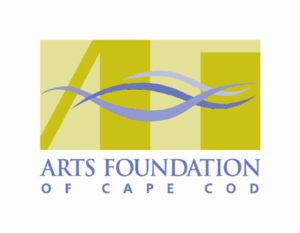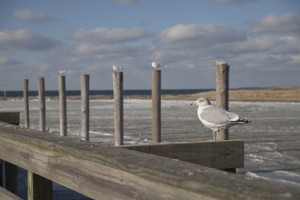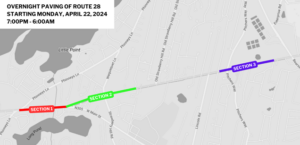A Post by Beverly Tilden
“Wait over there; under that tree…we’ll be boarding shortly.” Only 15 minutes to go and a small crowd had gathered in the noonday sunlight all squinting-eyes out over Provincetown Harbor and beyond. Could we catch a glimpse from here? 10 minutes to go and more people gather, families, couples, seniors and kids running everywhere.
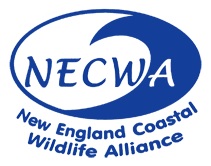
I hear Southern accents, some French, and some other languages I can’t identify but together, we start guessing. Five minutes to go and there are no seats on the benches or the cement wall…people of every shape and size, armed with coolers, strollers, hats and sweatshirts….all eagerly chatting about their adventure to come! Then the words we’ve been waiting to hear..”follow me, we’re going to board the boat!”
We turn the corner and the dock looks like it goes on forever. But a few minutes later we approach the end of the wood-planked road and approach two young women, one taking our tickets and one taking our picture. Then we march through a building, and as we come out the back, the expanse of Cape Cod Bay opens up before us.
My sister is visiting from LA and although I live here in Falmouth, I rarely get to Provincetown and even more rarely have a weekday off to play Cape Cod tourist! It’s a perfect blue sky day and the boat rolls softly by the dock. She’s the floating chariot that will take us miles north of Cape Cod Bay in search of whales.
Our boat has two decks, both with benches in the middle and around the sides. We start discussing, where will be the best vantage point to see the whales? We settle on the top deck in the middle and a suntanned woman with Ray Bans, that cover a great deal of her attractive, petite face, picks up the microphone. She introduces herself as Tiffany and tells us to block our ears.…there’s going to be a blast on the horn to signal that we’re leaving the dock and then three short blasts to let other navigators know we’re backing up. All hopeful whale-watchers cover their ears — we still hear: the engine churn, the sound of rushing water as the propellers turn, and then the horn blasts. We’re moving slowly from the dock.
Wildlife School
Tiffany’s back on the mic again, sporting an orange t-shirt with the NECWA logo in blue (New England Coastal Wildlife Alliance) and she introduces herself and her organization. She also presents the captain, and other members of the crew and lastly, Courtney Callahan, her intern at NECWA who is onboard to record data on the animals we see. She begins giving us a preview of where we’re going and what we hope to see. We are headed to Stellwagen Bank she says, an area where the ocean floor dips deep right off the north tip or Provincetown and spans an area north towards Gloucester.
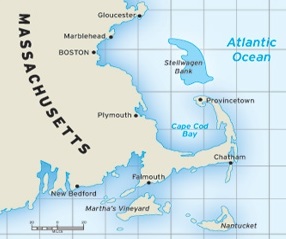
There are two kinds of whales, Tiffany explains, the Baleen whales, that we will see today and the toothed whales that actually include porpoises in their category as well as the familiar killer whales. The Baleen whales are named for their method of eating. They have baleen instead of teeth. Baleen is like a long curtain of thin rigid rods attached to the top of the animal’s mouth where upper teeth would normally be. It has two sides, a hard shell-like side facing outward and a soft hairy-like side toward the inside of their mouths.
To eat, the whale dives deep with their mouth wide open, gathering thousands of little fish and krill then closes its mouth and with its tongue pushes the fish and seawater up against the baleen where the fish are caught in the hairy side and the seawater is forced out through the narrow openings between the rigid baleen. Nature’s version of a very efficient filtering system! Nature also proves to be the first tailor too as the Humpbacks have a series of lines on the underside of their belly that are actually like pleats, expanding their outer skin to allow more water to come into the animal’s mouth as it dives!
Tiffany went on to explain that the reason the animals seek out these New England waters is that the nutrient filled cold water generates lots of fish food attracting lots of fish and these animals need to eat about two tons of fish a day to live and build up their blubber for their trek back to warmer waters in the Caribbean where they return each winter to mate and calve (give birth to a calf.)

She talks about the deep cold water that is the perfect habitat for algae, the smallest living creature; algae blooms when the currents push it towards the bank and forces the water and algae into the shallow warmer water. It’s that food that attracts the small fish that the whales feed on. They are tiny as fish go, about the size and shape of a pencil, and just the right size to fit down the narrow grapefruit size throats that are the characteristic of the humpbacks. There goes the “Jonah Story” I think to myself.
A humpback whale can grow to 50 feet long and 35 tons and females are usually larger. They are identified by their fluke pigmentation as well as other unique scars, their dorsal fin and their long flippers.
One more thing she says, “I need to tell you about our animal spotting technique based on a clock.” She goes on to familiarize everyone with the way she will point out the whales. The bow of the boat is 12 o’clock and the stern is 6 o’clock and she will call out the location of the whales based on the clock hours. “Now,” she says, “we need everyone to watch out for blows so we can spot the animals.”
It’s been about 30 minutes now and the Pilgrim Monument in Provincetown is a faint image in the haze and distance. “Many people think that the blows are water, but that is not true, the blows are warm air that the animal exhales as it blows into the cool air outside.” Tiffany clarifies our thinking and our memory of those Cape Cod folklore prints! My sister dares me to yell “Thar she blows” the next time a whale appears, I pretend I might do it just to keep her anticipation running high.
Mars, my nick name for my sister Marcia, and I have now moved downstairs to the bow of the boat and we’re thinking it’s a great place to see the whales. “I see one, over there,” yells a passenger. “Yes,” says Tiffany, “1 o’clock and everyone trains their view to the bow.”
Sure enough, off in the distance a spray of mist and the boat speeds up in that direction. Mars and I move through the crowd to get a view on the rail, we even make it out onto the bowsprit which juts off the bow above the water. Now the whales are closer and we catch a glimpse of our first dorsal fin as the animal surfaces for a few breaths. Tiffany explains their habit of breathing a few times and then deep diving for more fish and the last thing we’ll see is the tail as it’s raised high in the air to give them the leverage to dive deep. “It’s Dyad,” says Tiffany, “a female humpback that frequents the waters on the south end of Stellwagen.”
They have names! My sister and I looked at each other, wow! Dyad apparently comes back each year and is well known based on the white markings on her tail. Then a commotion at 10 o’clock as Dyad breaks the surface and lands on her side. “A breach,” Tiffany informs us. “We’re lucky, only 10% of trips will we see a whale breach the surface.” We watch Dyad as she continues to swim, dive and feed. The whales dive for 3-4 minutes and then surface for a few breathes, then dive again. “Some whales have been known to stay down more than an hour,” she says. “But we’re lucky again, they only seem to be staying down a few minutes so we see them more often.
Tiffany announces we’ll move on and soon we see more blows in the distance, lots of them. Tiffany thinks there are multiple animals and the boat speeds toward the blow points. We see recreational fishing boats drifting nearby and we join the group watching Pele, Jambaroo and Eruption surface, breathe and dive again, each time lifting their tails high to dive deep and displaying for the “watchers” the unique markings on their flukes or tail fins.
We have our eyes trained on the waters surrounding the boats when all of a sudden one of the humpbacks surfaces right near the small fishing boat, giving the crew quite a shock and it seemed to scare the whale too as they swim away, one slapping its flipper in annoyance! Again we watch the rhythmic dance as they swim and dive.
We’ve been waiting and watching for about 90 minutes now and it’s time to head back. “Up! At 4 o’clock,” Tiffany shouts with excitement, another blow is in site as we spot our fifth animal, a female named Freckles. Tiffany informed us about the females spawning in the warm waters of the Caribbean and noted that a female will carry their calf for a full year before it is born and that they need to give birth where the waters are warm as the calves don’t have the necessary fat to keep them warm in the waters off New England. We continue our journey back to Provincetown Harbor. Families are crowding together talking about the day, others quiet and tired from a day of sun and wind on the water.
Tiffany Davenport, Naturalist
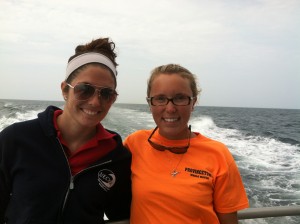
Mars and I retire to the snack bar for a cold beer and along come Tiffany and Courtney with some interesting items to share. A piece of a whale’s baleen was fascinating in its complexity of purpose. Also a tooth from a toothed whale and a plastic replica of the tiny fish the humpbacks feed on. Tiffany is extremely knowledgeable and we asked her about her experience. She lives in Kingston and each day takes the ferry from Plymouth to P-town where she boards the Noon whale watch for her job as a wild life expert on the daily whale watch trip. Then she sails back to Plymouth to complete her commute! At least there’s no traffic report needed! She graduated from New England College in Maine where she studied for a career as a naturalist.
We kid her about how she doesn’t seem nervous at all talking on the microphone and tell her that will be great experience for the rest of her career. She said she could barely speak at first she was so tense, but now that she’s comfortable she loves it! She introduced Courtney Callahan, a student at Salem State also enrolled in marine studies. Courtney’s role is to compile data each trip of the animals they see and their behavior.
I snap a of photo of Tiffany and Courtney and then say good-bye as they have lots more guests to talk with before we dock.
Mars and I retire to the deck to finish our beer and reflect on the day, but it’s too windy and the beer is blowing right out of our cups! A last laugh and we think what a great trip. Not only did we spend a beautiful day on the water, but witnessed the amazing lives of these most giant creatures and thanks to Tiffany, we learned a little something too. Learn more at www.necwa.org
Photos from NECWA.




